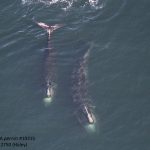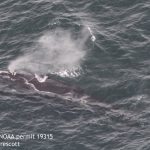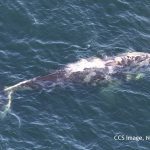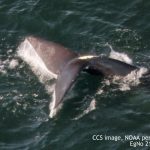February 2017
Another weather window allowed for a second aerial survey for this week. Once again, we found a group of right whales in the East side of Cape Cod Bay off of Wellfleet. All of these whales were subsurface feeding, spending a long time just below the surface and making them challenging to follow. We observed EGNO 3401 “Tux” and a smaller whale that is likely one of last year’s calves both for a second time. Right whale callosity patterns change a lot during their first few years of life and it can be difficult to match them to known calves. Therefore, because we recognize this young whale, but are unable to match it, we have given it a seasonal code of M083. In the future, curators of the photographic catalog at New England Aquarium (NEAq) will likely give this whale an EGNO and with hopefully match it to a calf, but until then we will refer to it by its temporary code.
We also photographed two new whales for the 2017 season. They were EGNOs 3333 and 2271 “Prescott” who have been regular winter visitors to Cape Cod Bay. It’s great to see them both back this year. Interesting to note, both of these individuals are also listed as “APB” whales.
Photo documentation of individuals on this list are tracked by some members of the North Atlantic Right Whale Consortium (NARWC) in near real-time. The aim is to study serious injuries and body condition as a way to monitor the overall health of individuals in the population, and this data aids in informing knowledge surrounding human-related impacts and survival. Our team here at CCS finds it imperative to contribute to this knowledge base, as we have the unique opportunity to observe many of these APB individuals when they could otherwise go undocumented.
AERIAL SURVEY 2/14/17
After nearly two weeks of terrible weather (including two significant snow storms) we finally got a flight in on Valentine’s Day.

EGNO 4140 and 2750, (Haley) coordinated subsurface feeding in Cape Cod Bay on 2/14/17. CCS, NOAA permit 19315
For almost the first half of the survey we didn’t have any sightings of large whales, and we thought we might be skunked for the day. But that changed substantially when we got west of Truro; there we found about 17 right whales over the course of two hours, and some could even be seen from shore!
We observed some familiar faces from this season, including EGNOs 3401, Tux and 3340, Plover, but for the most part the individuals sighted are new for this year in Cape Cod Bay. New whales of note include EGNO 1150 Gemini (named after his pair of scars on his back and first seen in 1979) and EGNO 1620, Mantis, who brought her calf in the bay in 2015.
After documenting the large aggregation on the eastern side of the bay we continued our survey and encountered one more right whale in the middle of the mouth of Cape Cod Bay. To finish our lines we had to refuel, so we did a very quick turnaround in Marshfield before completing our survey as the sun was setting. Overall a spectacular day!
AERIAL SURVEY 2/19/17
Having had such a high concentration of right whales on our last survey, we were excited to get out last Sunday and see what activity we could find in Cape Cod Bay. With calm winds forecasted all day, we departed early and flew in a North to South direction.
On the first few track lines we observed a few fin whales, and the first minke whales we have seen in a long time. Off Provincetown and down towards Truro, we once again found a concentration of right whales! These individuals all seemed to be feeding at depth. None were seen with their mouths open, and we noticed some mud on their heads, suggesting that they were feeding on the bottom. Their long dives and minimal time on the surface made it difficult to track these whales.
Out of the four individuals we have identified from this group so far, at least 3 are new whales for the season! They include EGNOs 3991, 3629, and 3301 (Neptune). EGNO 1706 was the only repeat whale that we have found so far.
While circling further to the south, right whale researchers aboard the R/V Resolve alerted the plane to a right whale with extensive scarring on its body back up towards the north of the Bay. As this description did not match any whales we had seen earlier in the survey, we returned to the area and confirmed that this scarred whale was EGNO 3530, Ruffian. This is a whale that was last seen in the Southeast US in January shortly after having been professionally disentangled by members of the Atlantic Large Whale Disentanglement Network. We wanted to be sure that Ruffian was indeed gear free, so we photo-documented him thoroughly; thankfully we didn’t see any gear. We called the disentanglement hotline based at CCS to alert them of our sighting and forwarded photos of Ruffian to them for a health assessment and confirmation of Ruffian’s gear free status. They later confirmed that they too couldn’t see any gear in the photos, and that Ruffian is suspected to be gear-free.
During the time that it took to properly document Ruffian’s body he was seen both skim and subsurface feeding. He was taking longer dives than some of the other whales in the area, but otherwise looked to be behaving normally.
Ruffian is a 13 year old male that has been seen with regularity in Cape Cod Bay in recent years. We were hoping that he would return to feed here again this year, especially after his disentanglement in the Southeast. It was a relief to see him alive and feeding. The right whale community will continue to look for Ruffian in the coming months and monitor his health as he recovers.
HABITAT CRUISE, 2/21/17
A sunny and relatively warm day for a cruise aboard the R/V Shearwater to collect plankton samples and monitor recent right whale activity in eastern Cape Cod Bay. Approximately eight miles west of Jeremy Point Wellfleet, we observed two right whales making deep dives with their flukes raised and took plankton samples there.
We proceeded to an area about two miles north of Corporation Beach in Dennis where the aerial team had spotted some right whales subsurface feeding. Although the whales had moved on by the time the Shearwater arrived, we took plankton samples to determine what they were feeding on. On the return trip to Provincetown, three right whales were observed surface feeding five miles west of Great Island; we photo-documented two of the three whales and again collected plankton samples before continuing back to port.
AERIAL SURVEY 2/21/17
Today we flew February’s Eastern Outer Shore Survey. We usually try to fly this region outside of the bay at least once a month in an effort to capture any whales that may be entering or leaving Cape Cod Bay, and to record any individuals that choose not to come into the bay. We observed four right whales while transiting through the bay on the way to our northernmost trackline. Only one of the four (EGNO 3401, Tux) had been observed so far this season. Two of the others are EGNOs 1802, Legato and 4023, Wolverine; the third is a yet to be identified, younger individual.
Once we made it out of the bay and to our survey area, we found a plethora of species: Grey and harbor seals, common and white sided dolphins, fin, humpbacks and pilot whales. We even had a cow/calf pair of minke whales, a rare sight for our observers.
Our fifth and final right whale of the survey was EGNO 2420, an adult female who has never been observed in the bay. She was last photo documented in 2011, so it’s good to see she is alive and well. It was great to see her subsurface feeding; unfortunately, it was right in the middle of the shipping lane. While we didn’t see any large ships in the vicinity, we can only hope she effectively foraged the food resource in that area, and moved out again quickly.
AERIAL SURVEY 2/24/17
The weather was beautiful, but high winds made for difficult spotting conditions. North of Truro, we spotted the first right whale blows of the day. The first whale, “Peanut” EgNo 2140, was a new individual for this season, adding to our total of over 30 whales seen so far this year. Peanut, a male born to EgNo 1240 “Baldy” in 1990, has been seen in Cape Cod Bay in recent years.
Our next whale was EgNo 3530 “Ruffian”. Still wanting to document this whale as much as possible, we spent quite a bit of time with him. Ruffian however, was doing long dives and spending very little time on the surface, making photo documentation very difficult.
During our time with Ruffian, we observed other exhalations from right whales, but their elusive behavior and long dives prevented us from getting photos. By this time, the winds and sea state had also picked up considerably and unfortunately we had to end our survey early. There is still a lot of right whale activity in the bay. Hopefully we will get out again and document more individuals soon.
HABITAT CRUISE 2/28/17
On February 28, 2017, with overcast skies and low winds, R/V Shearwater conducted a habitat cruise to photograph right whales and sample zooplankton where they were found feeding. Habitat Research Scientist Christy Hudak and interns Tim Famulare and Melissa Yow along with Captain Marc Costa departed Provincetown Harbor at 10:15am, heading South towards a group of ~12 right whales off Corporation Beach that were observed by the Center’s Aerial Observers Brigid McKenna and Alison Ogilvie aboard Skymaster.
Along the way, Tim and Melissa observed several right whales off of South Truro and Wellfleet that were surfacing for a few breaths and then diving repeatedly, presumably feeding vertically through the water column. Christy collected vertical tow samples in the area of these whales, and then again after we made our way to Dennis. On return to Provincetown, we observed 8 right whales skim feeding at the surface about 8 miles West of Jeremy Point. Interns and vessel observers Tim & Melissa collected photographic data and Christy collected surface town samples. All in all, by the time we made it back to port, we had observed 18-19 right whales and photographed 16-17.
AERIAL SURVEY 2/28/17
What a day! Since rain was predicted in the afternoon we got a really early start on Tuesday and took off from Chatham at about 0800. With calm seas, we began our survey in the southern portion of Cape Cod Bay where we encountered a feeding aggregation of right whales! It was somewhat spread out but definitely formed a slight diagonal line in the eastern portion of Cape Cod Bay extending from Yarmouth to Truro. With such great conditions it was easier to locate and photograph these individuals than in recent surveys, and overall we had about 25 different whales.
This includes newcomers to the season EgNo 1701 “Aphrodite,” EgNo 1425 “Butterfly,” and EgNo 1817 “Silt” to name a few. All three are adult females were first sighted in the 1980’s and have had at least 14 calves between the three of them. Like the majority of whales, Aphrodite and Butterfly were feeding, but Silt was breaching! It was amazing watching her break the surface over and over again and in total she breached four times.
Our last right whale sighting was a singleton off of Plymouth, and after that we had a pretty quiet survey. We landed shortly after 1400, just beating the rain by a few hours. As far as right whales surveys go this day was top-notch, but when considering its February it was spectacular.

Our Work
Humpback Whale Research
Right Whale Research
Marine Animal Entanglement Response
Marine Geology Department
Water Quality Monitoring Program
Marine Fisheries Research
Seal Research
Shark Research
Marine Education
Interdisciplinary
Marine Debris and Plastics Program
Marine Policy Initiative
Cape Cod Climate Change Collaborative
Publications









